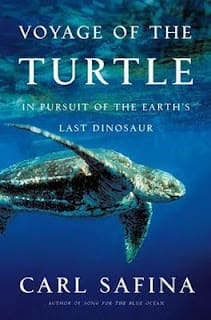Carl Safina’s mellifluous prose evokes the beauty and mystery of the sea and its ancient denizen, the Leatherback turtle
Voyage Of The Turtle: In Pursuit Of The Earth’s Last Dinosaur
by Carl Safina
Published by Henry Holt and Co.; 1st edition (May 30, 2006)
Rs 689 on Flipkart

Carl Safina is a marine scientist and the founder of the Blue Ocean Institute. This is his third book after the much acclaimed and award winning Song for the Blue Ocean: Encounters Along the World’s Coasts and Beneath the Seas and Eye of the Albatross: Visions of Hope and Survival.
The book is full of facts and data that can come from intimate contact and close study alone. For instance, the Leatherback is the only turtle that, after laying almost seven dozen billiard-ball-sized eggs, lays another two dozen embryo-less eggs on top, their purpose yet unknown. It is conjectured that they may play a role in providing air-space on the top of the nest, stabilize humidity or protect against fungal infection.
In another place Safina writes about the failure of the initial TEDs (turtle exclusion devices) since the opening size allowed only the juveniles to escape and it took years to enforce a larger opening by law. Or, for instance, that well into the 1990s, the Japanese imported turtle shells – 30,000 kg of it (amounting to almost 30,000 adult Hawksbill turtles harvested annually) to be carved into hair ornaments for ladies – a craft called bekko.
Through his travels Safina cites several cases that underscore how difficult (and counter-intuitive) it can be to formulate a sustainable and effective conservation strategy. For example, in Malaysia, the Leatherback population has plummeted from 10 to 15 thousand adult females and 3,000 annual nesters in the 1950s to virtually zero today. For 50 years almost every egg was taken and when finally artificial incubation was tried out wrong temperature control produced either all females or sterile intersex individuals.
In Florida, beachfront high-rises and luxury condos that adhere to a strict night-time “light curfew” offer a safe backdrop for hatchlings crawling towards the sea. The open beaches close to the towns disorient them, the hatchlings mistaking the light-polluted land horizon for the real one. Having evolved on Earth where for millions of years the horizon is the brightest pre-dawn area, for the turtles such disorientation means almost certain death. Clearly, there is no substitute for accurate scientific knowledge, more often than not gained painstakingly on the field. Romantic greenhearts take note. Throughout the book Safina succeeds in seamlessly relating the plight of the species to the larger issues and threats that plague the oceans and touches upon the other surviving sea turtles as well – the Green Sea Turtle (Chelonia mydas), Hawksbill (Eretmochelys imbricata), Flatback (Natator depressus), Loggerhead (Caretta caretta), Kemp’s Ridley (Lepidochelys kempii) and Olive Ridley (Lepidochelys olivacea).
Safina’s prose is mellifluous and evokes the beauty and mystery of the sea. One of the most poignant passages in the book, just after he has described the newly hatched Leatherbacks on their first swim, full of life and oblivious to the threats that await them every single moment of their lives, summarizes the moment of extinction, “The end of a species comes as tranquilly as this gentle sunrise. There’s no final struggle, no valorous last stand or terminal flourish. Just one final puff of breath, then mere absence. No creature mourns its own passing. The grief and the consequence lie solely with us, but few feel the loss.”
The book is one of the finest on natural history I have read and a must-read. It is guaranteed to make you fall in love with the oceans and their denizens especially the large brooding vagabonds of the blue – the Leatherback.
Reviewed by Sahastrarashmi
- Encounter: The Sacred Grove at Oorani - November 28, 2012
- Encounter: Rhododendron, sentinel of the highlands - October 7, 2012
- Manjhi Akshayavat, an immortal Banyan tree - July 17, 2012


